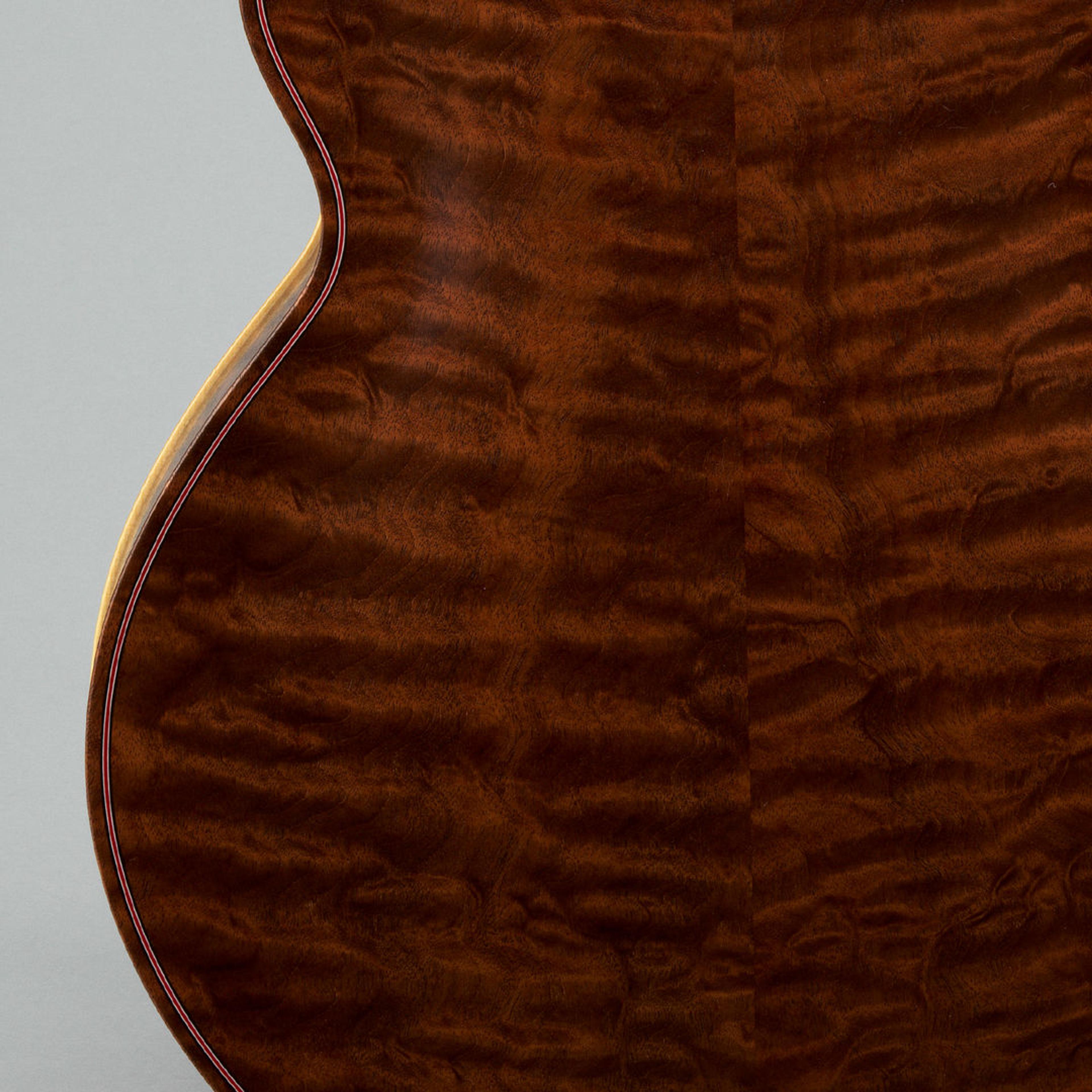How did one tree become a world-famous tonewood for guitars?
Deep in the forests of Belize, a wood importer from Florida discovered a rare tree that produced a sound unlike anything guitar virtuosos had ever heard before. But why does this material cast such a spell? And at what cost does that come?
Read the illustrated transcript below.
Listen and subscribe to Immaterial on Apple Podcasts, Spotify, YouTube, Amazon Music, or wherever you get your podcasts.
Season 2 of Immaterial is made possible by Dasha Zhukova Niarchos. Additional support is provided by the Zodiac Fund.
Transcript
CAMILLE DUNGY: Our story today is about a mahogany tree. One that lived for five hundred years in a forest in Belize and that is rumored to have magical qualities. It might just be the most valuable tree in the world. But we won’t start in Belize.
ELLEN RUPPEL SHELL: My husband and I, we live in Maine about half the year and we decided to go to Boothbay Harbor.
DUNGY: We’ll begin more than 3,600 miles north at a craft fair in Boothbay Harbor, Maine.
SHELL: When we got there, we kind of wandered around from booth to booth.
DUNGY: That’s author Ellen Shell. As she walked around, there was one booth in particular that intrigued her.
SHELL: A woodworkers booth.
DUNGY: He had the usual stuff.
SHELL: Cutting boards, bowls, all these things.
DUNGY: But what caught Ellen’s eye was a guitar.
SHELL: Now I play guitar very badly, but I do love guitars and they generally do catch my eye. But this one in particular, I’d never seen anything like it.
DUNGY: The guitar’s dark brown wooden surface looked almost like a rippling, watery reflection.
SHELL: What it looks like in a sense is almost like a topographical map with these whirls and dips and seems almost random but it all sort of comes together in this very unusual way. You know, it’s something you almost have to see to believe because the way I’m describing it doesn’t do it justice at all. But it really pulls you in. It’s very, very evocative. It seems to be telling you a story.
DUNGY: So Ellen went to David Smith, the woodworker who owned the booth, and asked if she could see the guitar up close.
SHELL: And Mr. Smith was kind enough to take it off the wall of his booth and hand it to me and, and say, why don’t you give it a try?
DUNGY: Ellen started to play. And as soon as she started strumming, she noticed something. She sounded good. Like… really good. She couldn’t believe what she was hearing.
SHELL: This instrument is just exquisite. I mean, listen to this, even I can make this sound good.
DUNGY: Standing there with the guitar, she had so many questions.
SHELL: I mean, what is this thing? Why does this look like it looks? And he said, it’s from The Tree. And I said, what are you talking about?
DUNGY: THE TREE.
SHELL: That kind of opened up that chamber of wonders to me of the whole story of where this wood came from. That’s how I tripped over this. Completely by accident.
[MUSIC]
DUNGY: From The Metropolitan Museum of Art, I’m poet and writer Camille Dungy, and this is Immaterial. This week, wood.
—
DUNGY: When author Ellen Shell found herself entranced by the guitar, she set out on a journey to find out where its wood came from and to write a story about it. She wanted to know why wood from the so-called Tree cast such a spell. What is it about this wood that enchants people so much? How did she get so taken by its sound?
So she started to look into it. And found out that the special wood in this guitar was from this single mahogany tree that sprouted in the Chiquibul forest in present-day Belize. It’s just south of Mexico on the east coast of Central America.
Over the course of five hundred years, The Tree grew one hundred feet tall and twelve feet wide. These are blue whale proportions. And this massive tree stood in that forest, until one day in 1965, when a group of local loggers stumbled across it.
SHELL: What they saw was this twisted, tormented tree. I think of it as a gigantic olive tree.
DUNGY: With a trunk that was thickly twined, shooting up towards the sky.
SHELL: And I imagine this tree looked like that, which is why they targeted it.
DUNGY: Maybe the loggers wondered, if the outside of this massive mahogany tree was that gorgeous, just imagine what the grain of the wood inside would look like. Loggers in those days had somewhat of an obsession with old growth mahogany from Central America. It was a rarity. And these loggers were following in the footsteps of a long history…
Starting in the 1600s, colonial Americans and Europeans coveted old growth mahogany from the Caribbean and Central America. They cut down a lot of these trees. The mahogany trade was this enormous, devastating industry—one that relied mostly on the labor of enslaved people, and left forests stripped of these old growth trees.
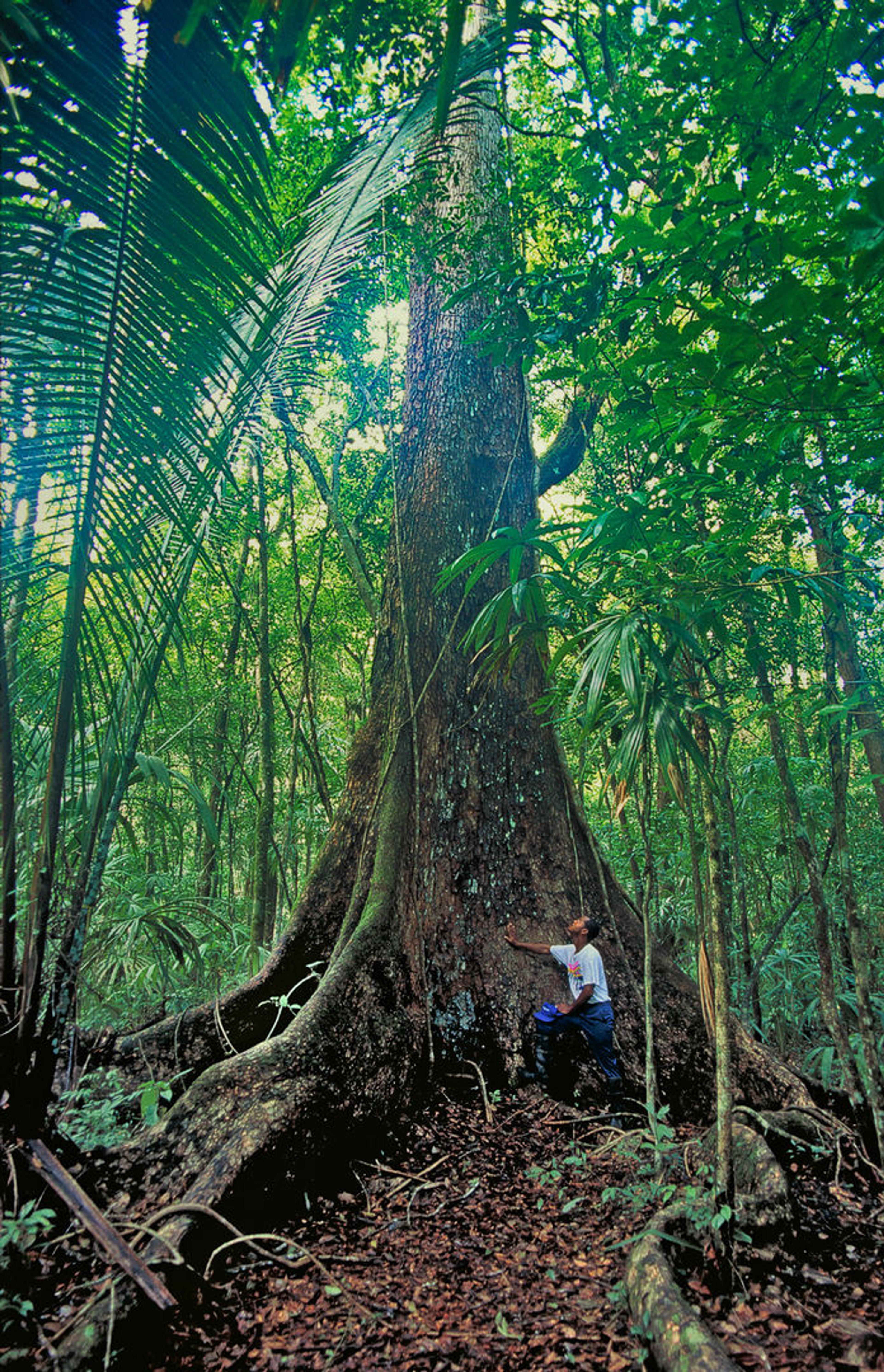
A mahogany tree just outside Chiquibul National Park. Photo courtesy of Tony Rath
For all of these reasons, when that group of local loggers found The Tree in 1965, they may have been surprised. By the 1900s, old growth mahogany was a rare material. And this mahogany was particularly gargantuan and unique looking. So the loggers decided to cut the tree down.
Felling The Tree was going to be an ordeal. Chainsaws weren’t common at the time, and…even if they were, they wouldn’t have been much help since mahogany is such hard wood. Chainsaws would get stuck. So they had to chop it down with hand saws and axes.
SHELL: Now you have to imagine this, this thing was twelve feet in diameter. Think of a six-foot-tall person, two of those, that’s what it was in diameter. No one knows how long it took to cut this down, but it probably took days.
DUNGY: Eventually, they were able to bring the tree down. But there was a problem.
SHELL: When it came down, they were obviously hoping to drag it out of the forest. And what happened was it twisted as it fell and it fell into a ravine. So at the time, they made an effort to get it out with tractors. They did whatever they could, but this is the Chiquibul jungle in what was then British Honduras. It’s extremely dense undergrowth. There are really no paths there.
It has these howling monkeys. It has these vipers. It has tarantulas. You know, it’s kind of like, okay, so you’re there in this very remote part of the jungle, especially in 1965. So they gave up and they left it in this ravine.
DUNGY: For years, The Tree remained untouched in that ravine, and the story reached a wood importer from Florida: Robert Novak. Like those colonial Americans centuries ago, Novak was willing to go to extraordinary lengths to make his fortune in Central America.
SHELL: He was an adventurer. He would travel the world, not only looking for wood, but also looking for other valuables.
DUNGY: Robert Novak went on a shopping trip to Belize to find rare hardwoods he could sell to furniture makers, and he heard about The Tree.
SHELL: And again, being an adventurer, he went out to look for it.
DUNGY: Novak anticipated that if the tree was as incredible people said it was, it would be worth a fortune. At the time, mid-century modern furniture and Studio Craft movements were gaining popularity, and furniture makers specifically wanted rare, “exotic” woods like old growth mahogany for their work. Novak was capitalizing on a trend. He assembled a local team and set out into the forest in search of The Tree.
SHELL: The amount of time it takes to get to penetrate that jungle just to get through a few hundred yards is just enormous. It’s this impenetrable jungle.
DUNGY: The team navigated through dense undergrowth. And remarkably, Novak actually found the tree in the ravine.
SHELL: It’s really amazing that he found it. It’s a needle in the haystack.
DUNGY: Once he found the ravine, Novak had another problem: how was he going to transport this massive tree back to the U.S.? The felled tree was as long as three school buses. There was no easy way for Novak and his group to just drag the tree out of the ravine. So he left.
For years, though, Novak schemed to assemble a team that could return and lift the tree out of the Chiquibul forest. According to his colleague…
SHELL: Novak was obsessed with getting it. Which you kind of have to be. I mean, it’s a crazy idea. To try and get this thing. And he was obsessed.
DUNGY: That’s the kind of spell that this tree cast on those who laid eyes on it. Some years later, Novak went back to Belize. The solution they came up with was to cut the tree into manageable chunks…
SHELL: Right there on the jungle floor and then haul them out I believe it was two hundred miles, through the jungle to a river. And then float them down the river to the only sawmill in Belize large enough to handle this tree. And what they came up with, I think, was 12,000 feet of tree.
DUNGY: Once Novak had The Tree, he had to create a market for it. Spread the word far and wide that this wood was unlike any wood people had ever seen.
KEN PARKER: I knew about this tree material probably a long time before any guitar makers knew about it.
DUNGY: That’s Ken Parker. He’s a luthier—someone who makes guitars. He remembers receiving a brochure advertising the tree. He was working with a furniture maker in Rochester, New York in the seventies.
PARKER: 1972 or something. We got a four-color brochure on this tree material from somebody that had some for sale. And I can’t remember the prices exactly, but it at that time was an unbelievably extravagant expense. Many, many, many times as much as perfectly good wood that we could buy at our favorite suppliers. And it was just kind of out of the question. Of course, we all wanted it.
DUNGY: Mahogany is considered one of the best woods for making the backs and sides of guitars. Ken and his fellow guitar makers started to imagine what could happen if they could use The Tree to make music.
Getting their hands on The Tree wasn’t going to be easy though. Novak’s storytelling around The Tree had created such a market that only the extremely wealthy could afford The Tree, even then.
PARKER: It cost so much money that it was all snapped up by these big architectural furniture firms, you know, that did things like libraries and houses for billionaires and stuff like that.
DUNGY: But Ken couldn’t help himself. He knew he needed to get his hands on The Tree from the moment he saw it in that brochure. So he spent…
PARKER: A hysterical amount of money.
DUNGY: And bought the wood.
PARKER: So yeah, I have, I have a nice supply of it.
DUNGY: But why would all of these guitar makers spend so much money to buy wood from this particular tree? What was it about this tree that made it so special? Our producer, Emma, asked Ken.
EMMA VECCHIONE (Producer): Do you know why luthiers, the guitar community started becoming interested in The Tree?
PARKER: Well, why Emma it’s just so plain as the nose on our faces, I mean, it's just, it’s stupefyingly interesting to look at. I mean, if somebody gave you a piece of it, you’d say, “Ah! What’s this?” I mean, it’s completely arresting and there’s nothing like it.
VECCHIONE: Could you describe for someone who can’t see this, what does this looks like?
PARKER: Oh, how do I do that? [LAUGHS]
I mean, you could just stare at it, you know, sort of looking, it’s like looking into a pond or something. It looks like it keeps changing.
DUNGY: Ken shows off a thin piece of wood from The Tree as he speaks. It is lustrous and dark, with a grain pattern—or figuring—that appears like undulating ribbons of light.
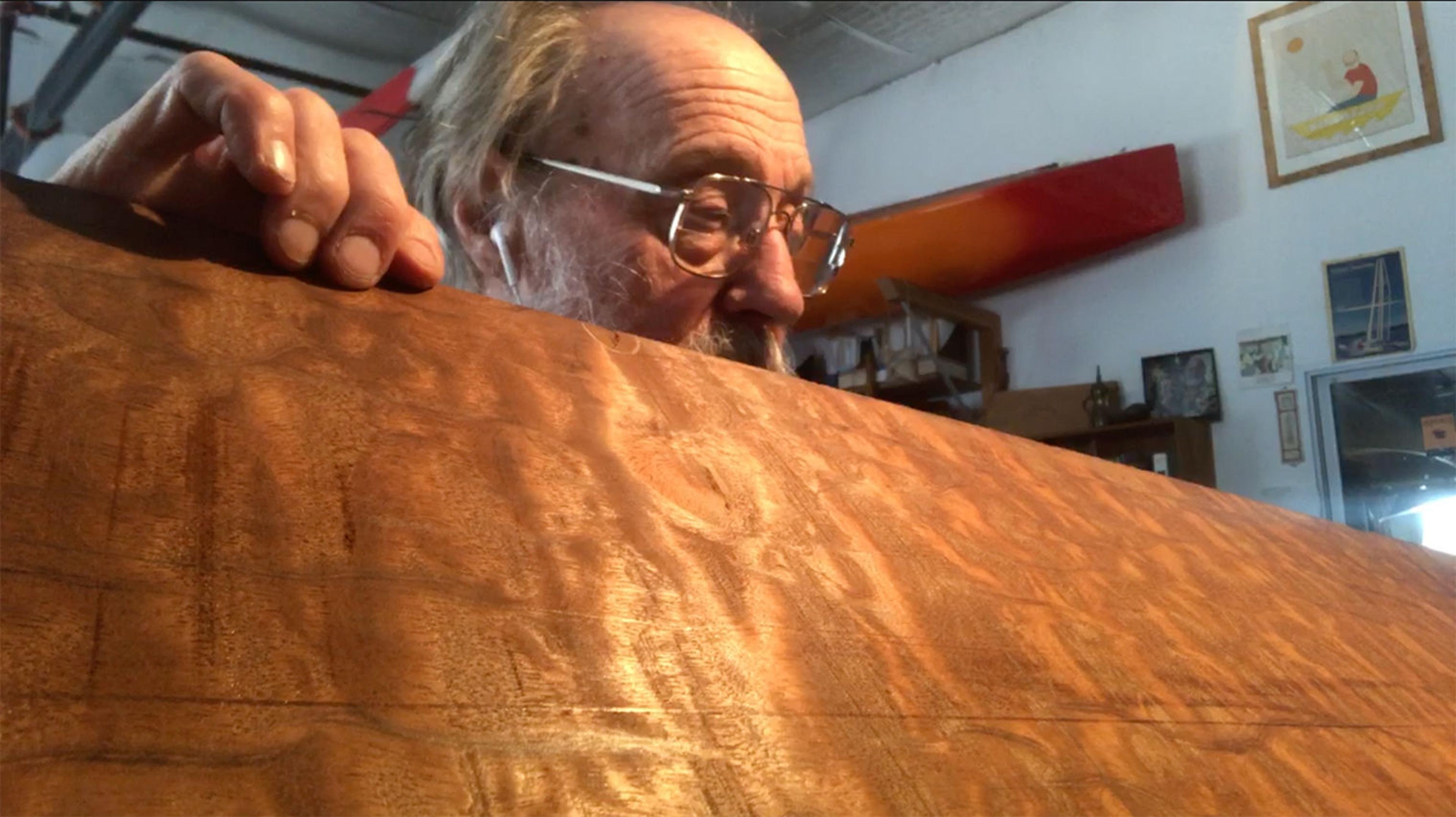
Ken Parker shows off a piece of wood from The Tree at his studio in Gloucester, Massachusetts
PARKER: And it’s a fantastic material from the point of view of the fabricator. I mean it’s sort of medium everything. It’s medium stiff, medium dense, it’s super stable, super stable compared to other materials. It’s delicious to work with.
I mean, it’s, it’s creamy, it’s yummy. It doesn’t have any bad habits. So, I mean, so far as wood is concerned,, it’s hard to imagine anything that would be more pleasant and rewarding to work with. Again, when you’re all done, you get to look at it. It’s just astonishing looking, you know?
DUNGY: For Ken, there were two reasons why The Tree cast such a spell in the guitar world: it was incredible looking, and wonderful to work with.
A few years after Ken bought wood from The Tree, he still had some. In 2015, he was commissioned to create an instrument for The Met Museum’s collection of important guitars. He thought The Tree seemed like a perfect material for this instrument.
PARKER: It was designed to be a special piece for a special application. And so I used my special material.
DUNGY: And the guitar is truly special. Ken used The Tree for the back and sides and neck of the instrument. The wood on Ken’s guitar moves from a rich reddish color, to a deep chocolate brown, with ripples of brighter, nearly golden highlights as if the wood itself might be rippling in time with whatever music the instrument produces.
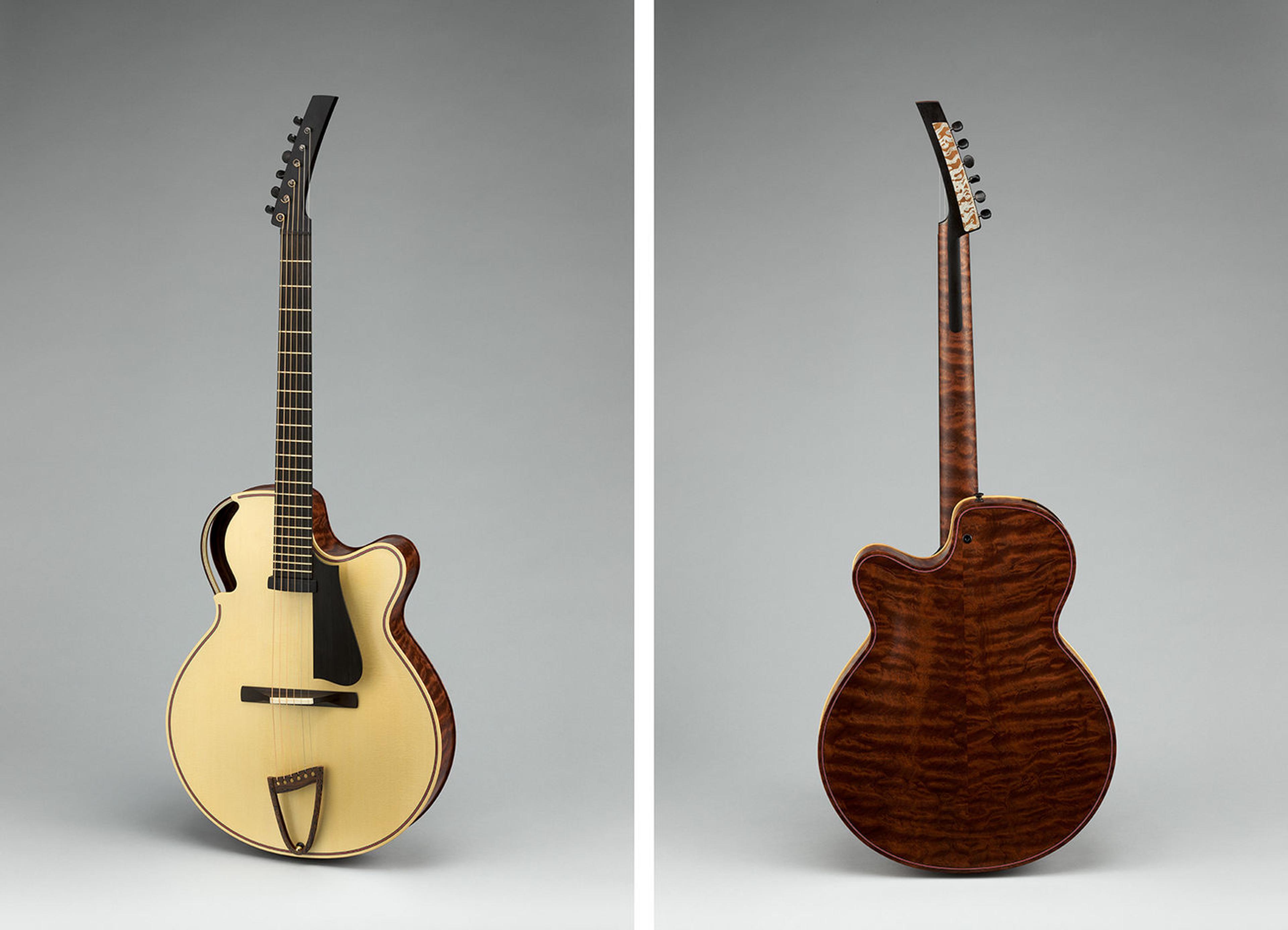
Ken Parker (American, b. 1952). Archtop guitar, 2016. Alpine spruce, mahogany, holly, cherry, willow, ebony, mother-of-pearl, camel bone, Douglas fir, carbon fiber composite, mokume-gane, 35 x 18 in. (88.9 x 45.7 cm). The Metropolitan Museum of Art, New York, Purchase, James D. Krugman and Connie Simmons Krugman Gift, 2016 (2016.124a–d)
To Ken Parker, the tree’s allure was in its appearance and quality. But other luthiers were attracted to The Tree for different reasons.
REUBEN FORSLAND: One of my thoughts was, I want to work with things that tells us a story, connects with us emotionally. And I thought, well, The Tree mahogany has this magical story.
DUNGY: This is luthier Reuben Forsland. He was drawn to The Tree for its story. Not the story of Robert Novak and his twentieth century extraction, but the story of what happened to The Tree in those five hundred years before it was cut down.
FORSLAND: This Tree mahogany grew alongside a ravine. If it’s close to a ravine or a slope, the tree will actually have to, as it grows, modify how it’s growing so that it’s growing up straighter because naturally it’ll wanna fall.
DUNGY: As it grew, The Tree may have twisted and turned alongside the ravine. And over five hundred years, it was battered by countless hurricanes, floods, and high winds. Through it all, The Tree stood tall. To Reuben, the intricate figuring of the wood evokes the life The Tree lived.
FORSLAND: It’s basically a wood painting. It paints itself.
DUNGY: Like most luthiers, Reuben couldn’t really afford wood from The Tree. It was way too expensive for him to use regularly.
But… someone Reuben knew had access to enough wood from The Tree to make a guitar. Reuben traded one of his custom guitars in exchange for the mahogany. He was really excited. But he didn’t know how best to use the material. He wanted to use it for something special.
FORSLAND: And then a week later, I ended up getting a commission to build for Slash. And then I was like, okay, here we go. I better do this right.
DUNGY: Reuben is talking about the famous guitarist Slash from Guns N' Roses. He was excited about this opportunity, but he also recognized he was working with an extremely valuable piece of wood. The most valuable piece of wood.
He needed to make sure his work on this was perfect. He arranged the Tree pieces into the shape of a guitar and began gluing them together. In that process, luthiers have to cajole the side pieces to form the curves of the guitar. This stage is called side bending.
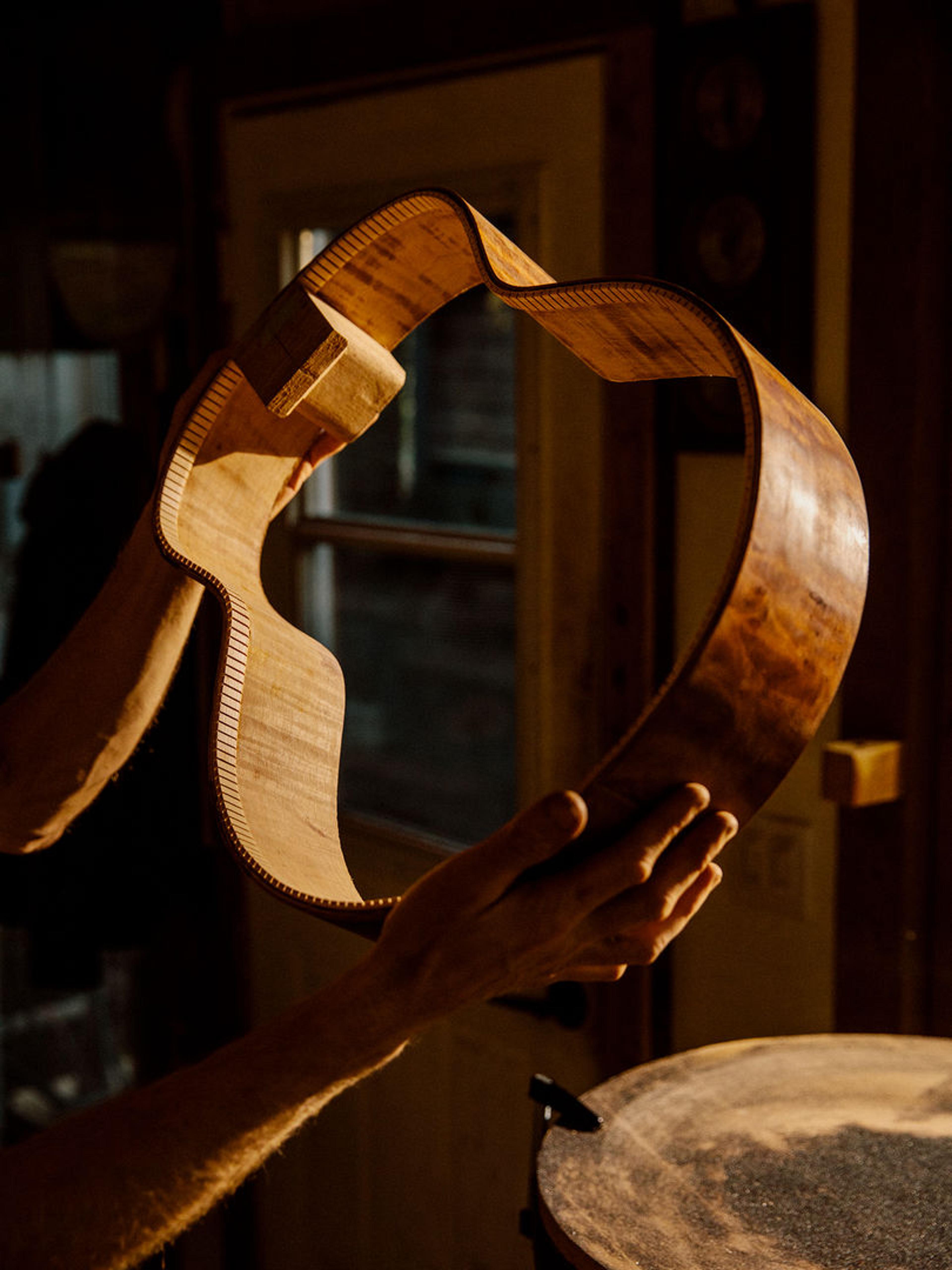
Reuben Forsland, luthier of JOI Guitars, steam-bends mahogany from The Tree. Photo courtesy of Grant Harder
FORSLAND: That’s the most dangerous part.
DUNGY: At this point, the wood can crack or break. For any number of reasons.
FORSLAND: You rushed it and you’re trying to bend the side faster than it wants to.
DUNGY: This time, the process went smoothly. So he kept going.
FORSLAND: Sanding the wood down, putting it all together, making it a beautiful visually looking piece. But once it’s played, it’s like unraveling a whole ‘nother story.
DUNGY: For a story about guitars, I’ve spoken very little about the sound of the so-called Tree. The music is a huge part of all of this! And that was Reuben’s biggest concern as he was finishing his instrument for Slash—did the guitar sound…good?
Luthiers understand how guitars work. They know how to play guitars. But to them, a guitar only really sings in the hands of a talented player. So, Reuben went to deliver the guitar to Slash in L.A. in person. To hear his guitar made of The Tree come alive.
FORSLAND: The last four days before I had slept like five hours. And I was just doing micro work in the hotel like an hour and a half before delivering it, ‘cause I was like, this has gotta be perfect. So, delivered it and I met with him on Sunday.
DUNGY: Reuben handed Slash the guitar he had toiled over for months.
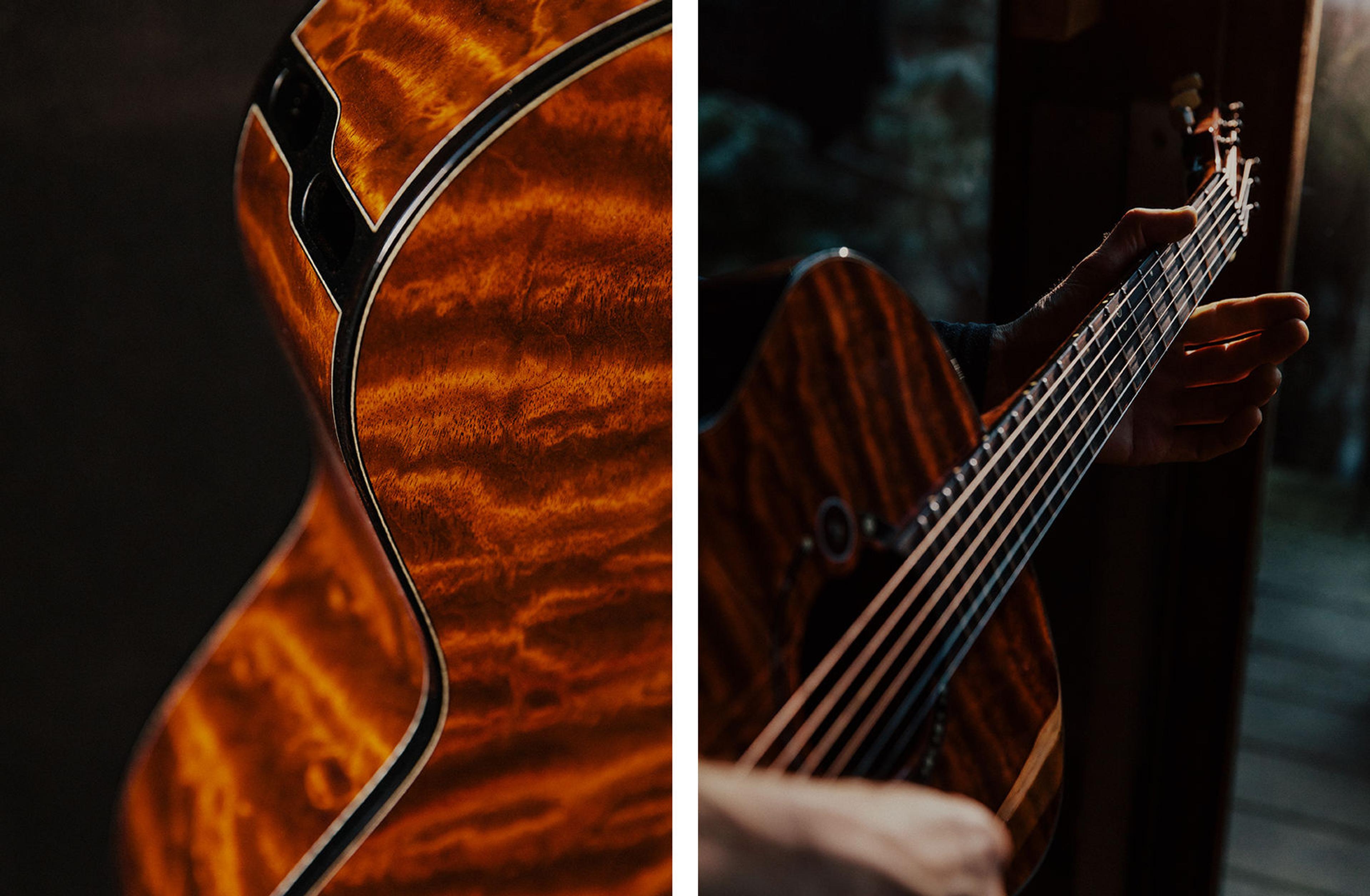
Left: One of Reuben Forsland’s guitars made of wood from The Tree. There is currently no conclusive evidence about what causes figuring like this in wood, but scientists theorize that it may be a combination of genetic and environmental factors. Right: Reuben Forsland tests a guitar he made with wood from The Tree. Photos courtesy of Grant Harder
FORSLAND: He just started playing it and, he’s like, “Man, you really did it, man.” He’s not a man of a million words, but he just kept it simply. He’s like, this thing really is a magical guitar.
I swear I just sat there with a massive grin on my face. I just sat there like, like a kid just grinning ear to ear. It sounded beautiful. it sounded like I had hoped it might.
DUNGY: To Slash and other guitarists, the sound of guitars made with wood from The Tree is truly unlike anything else. The Tree has this warm and rich tone. For some, that’s a huge part of why The Tree is so coveted.
After all of this talk about the guitar, the producers and I still hadn’t actually heard a guitar made out of wood from The Tree. So we asked the Musical Instruments department at The Met if they could bring out Ken Parker’s instrument and invite a player, Steve Cardenas, to test it out.
Without further ado, here is The Tree…
[GUITAR TUNING]
STEVE CARDENAS: Oh yeah. You can tell it hasn’t been played in a while because it’s way flat. It might take a minute for it to adjust. I mean if it hadn’t been played in a while and someone did tune it up it probably went right…
[STRUMS]
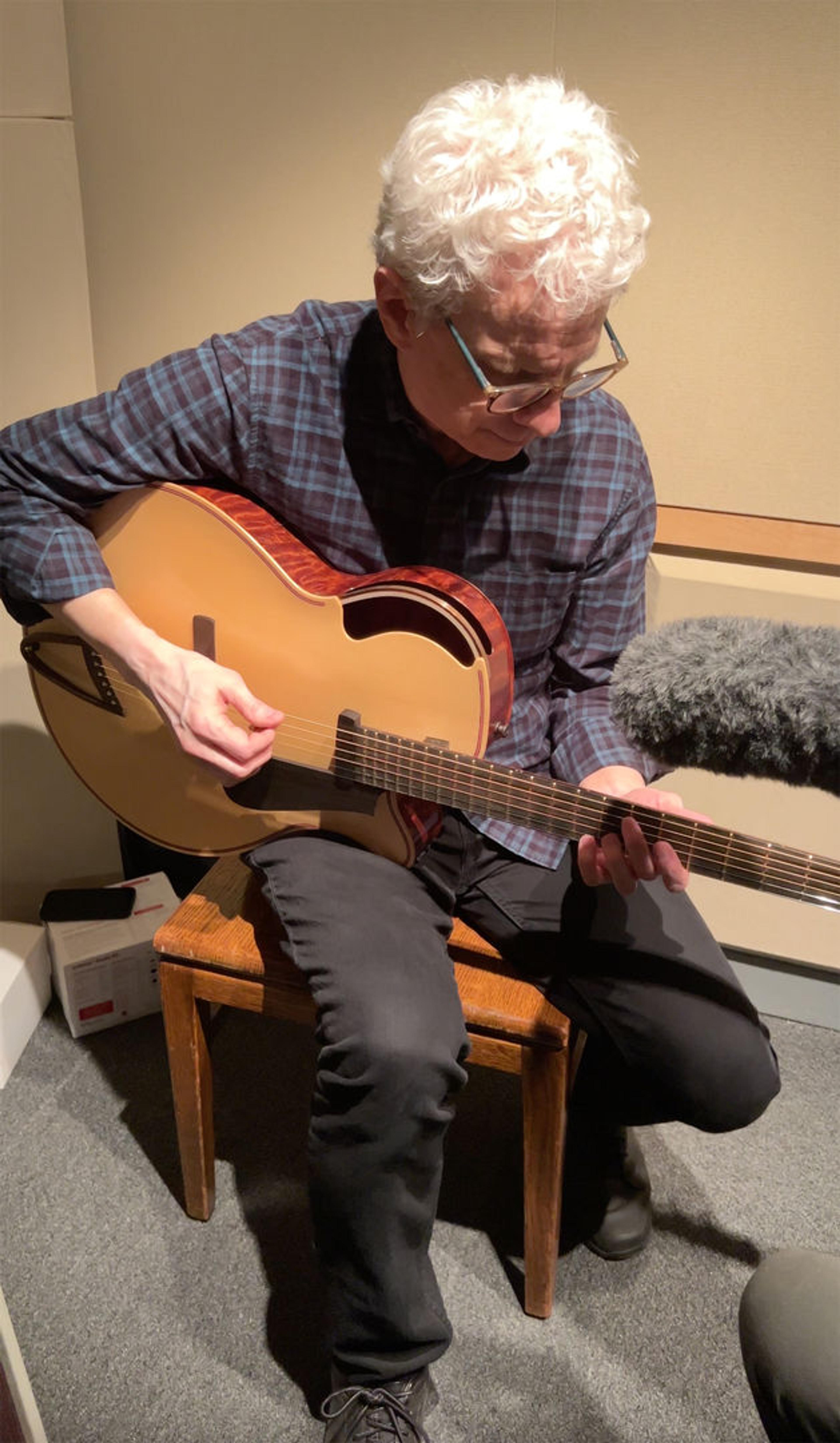
Steve Cardenas plays Ken Parker’s archtop guitar
CARDENAS: Okay. We’ll see how it sticks for now.
[GUITAR PLAYING]
DUNGY: The wood is beautiful to look at, but more than that, it contains an entire five-hundred-year-history inside of it. A story of a tree struggling to survive in nature—growing alongside a ravine, twisting and turning to reach the sun. And when a guitar made from The Tree is played, that story comes to life again and again, in warm, resonant tones. As a player playing that wood, you become a part of that story.
But there’s another side of the story.
ALTHEA SULLYCOLE: You know, the guitar is such an iconic instrument. There’s so much mystique around having a special kind of guitar…we’re kind of overlooking a relationship to resources.
DUNGY: The dark side of the trade of mahogany. After the break.
[MUSIC]
—
DUNGY: It’s easy to get swept up in the allure of wood from The Tree—in its beauty, its rarity, the story behind it. But in the spell this material casts, something becomes lost:
The troubling history of the trade of old growth mahogany trees at large. This history is the reason why this type of wood had become so rare by the time Robert Novak extracted The Tree.
JENNIFER ANDERSON: I was really surprised to learn that nobody had really done a history of mahogany of the kind that I was interested in doing.
DUNGY: Jennifer Anderson is the author of Mahogany: The Cost of Luxury in Early America. Her research revealed that Americans and Europeans had been extracting tropical mahogany from the Caribbean and Belize for centuries.
In the 1600s, European settlers colonized the region and violently cleared forests of mahogany to make space for sugar plantations. Soon, they realized the value of this material—that it was beautiful, and easy to work with. By the 1700s, wealthy colonial Americans and Europeans became obsessed with old growth mahogany.
Owning tea boxes, cabinets, chairs, all kinds of furniture made out of imported mahogany, was a status symbol.
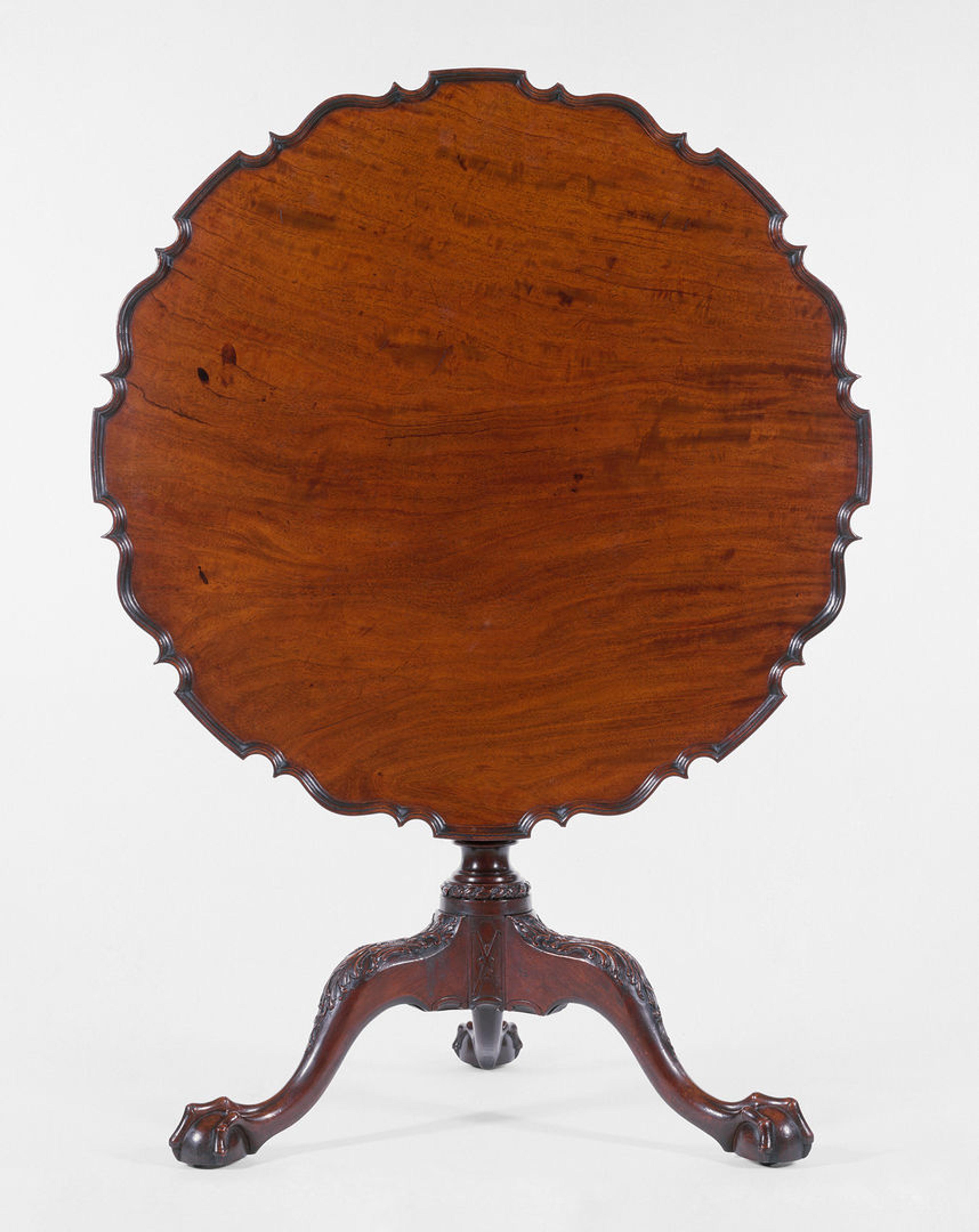
Tilt-Top Table, 1765–75. United States, Philadelphia. Mahogany; brass, iron, 27 1/2 x 33 3/8 in. (69.9 x 84.8 cm). The Metropolitan Museum of Art, New York, Rogers Fund, 1925 (25.115.31)
ANDERSON: You’d say, oh, I’ll get a mahogany tea box. That’ll be special. I’ll show that to my friends. It’s very much a period where people are, you know, interested and desirous of what’s new and exotic.
DUNGY: That physical distance, that ‘exotic’ quality, gave these extracted resources an aura of luxury.
ANDERSON: And, then more and more people begin to aspire to emulate that fashion.
DUNGY: This “fashion”… had an extremely ugly impact. It increased demand for the wood in the eighteenth century. European colonists and plantation owners sent enslaved people to Central America. These Black men and boys did the dangerous work of extracting the trees from the forests of Belize. In the archives, Jennifer found an account of one of these people.
ANDERSON: One of the people whose story I follow was a young man and he somehow ended up enslaved in Rhode Island, and he was owned by a wealthy sea captain. And at one point his owner, so to speak, must have decided that he didn’t have enough work for him in Rhode Island and so he sends this young man, Newport, down to the Bay of Honduras to work for another of his associates as a woodcutter.
DUNGY: Once there, this young man joined a crew of other enslaved woodcutters.
ANDERSON: The way it worked was that these crews would be sent into the rainforest. And in each crew, there would be one man who was the huntsman, was what he was called. And it would be his job to figure out where these trees were because they tended to grow very spread out within the forest. And he would lead his crew to one tree at a time.
And they would haul that one tree as close as they could to a river. And they would, basically push these massive trees into the river and then float them down to the harbor at Belize City. So it was quite an involved process.
DUNGY: Enslaved people like the young man sent from Rhode Island were forced to navigate a nearly impenetrable forest in search of centuries-old mahogany trees.
And unlike Robert Novak, that wood importer who went willingly into the forest to make his fortune, these people were forced against their will to destroy the trees. Horrifying numbers of enslaved people were brutalized, injured, and killed in the extraction of mahogany.
And as demand for mahogany grew, the lands these trees grew in were totally and profoundly changed for the Indigenous communities who lived in the region. Where there were once towering trees, now there were just stumps. And scarred swaths of land to support the trade of the trees. This left Indigenous communities drastically displaced, and they were denied access to environmental resources, as well as the places critical to their ancestral and cultural traditions.
The legacy of this industry was irreversible. And it wasn’t like more of these trees could just be planted.
ANDERSON: Most of these trees that were being used, were, some of them easily a couple hundred years old. So mahogany is essentially a non-renewable resource. It’s very difficult to find these trees of the size that once were harvested because so many of the really big ancient ones were cut down.
DUNGY: Today, there are very few of these old growth mahogany trees left.
ANDERSON: And they’re all endangered and protected under the CITES Treaty for Endangered Species, which means that you can still cut them today, but it’s highly regulated.
DUNGY: In the early 2000s, after some major public relations campaigns, the dire state of these forests became more widely known. And an international agreement limiting the trade of old growth mahogany was passed—the CITES Treaty.
The massive tree that Robert Novak discovered in the 1970s—The Tree—was harvested at a time where restrictions were much more relaxed. In this day and age, illegal logging does happen, but wood importers like Novak would have a more difficult time getting away with exporting an old growth mahogany like The Tree.
Since The Tree was cut down before these restrictions were in place, luthiers with the proper permits can still use this wood to make guitars. But The Tree’s supply is dwindling, and there is nothing that can take its place once it’s gone.
Some say that its qualities are completely unique. Because of this, there’s a kind of hype culture around The Tree, especially within some guitar subcommunities.
SULLYCOLE: You know, the guitar is such an iconic instrument. There’s so much mystique around having a special kind of guitar, vintage guitar, rare guitar, right, that these resources get to really start to be seen as sort of a means to a certain kind of status within that broader culture.
DUNGY: This is Althea SullyCole. She is a trained classical and flamenco guitarist and a former fellow in The Met’s Musical Instruments department. Today, she mostly plays a West African stringed instrument called the kora. To Althea, there is a culture of obsession and scarcity built into the guitar community.
SULLYCOLE: Learning guitar was a very competitive experience. You know, you’re always kind of sizing yourself up against other people. And then on top of that, you know, like much of the music industry, it’s pretty male-dominated.
DUNGY: Such a competitive culture is rife with romanticization. According to Althea, it’s easy for some guitar subcommunities to get caught up in obsessing over the qualities of different types of wood. But in that romanticization, we overlook part of our relationship to these resources.
SULLYCOLE: We kind of miss out on what our true relationship is to these resources. I did not touch the raw wood before the instrument came to me. I have no idea how the nylon strings that I play on my classical guitar, how they’re produced.
And just by contrast, you know, I work mostly in the West African context. And there you see that oftentimes you have to ask for permission to use a piece of wood and that that involves some kind of ritual to cut down a tree. You have to really go through a process of recognizing the loss of that, that tree, the interdependence of the culture on that natural environment.
DUNGY: For the most part, guitarists and luthiers don’t play a role in cutting down these trees.
SULLYCOLE: We’re kind of overlooking a relationship to resources. Even the use of something being a resource kind of denotes that it’s defined by its use to us in a wider industry, rather than existing as part of an ecology on which we are dependent.
Overlooking not just like our relationship, say, from hundreds of miles away, but I think also our relationship like, people who have historically lived in those lands and lived in those parts of the world and how they have treated those environmental factors over time.
DUNGY: Overlooking that relationship has had a profound impact. It helps create narratives around the tree devoid of its historical context, feeding into a hype culture that exoticizes the sound of the material. It all creates a desire to collect and buy more and more because of how special it is.
PARKER: People have made claims about this material, which are just this side of hysterically funny.
DUNGY: They say it sounds like nothing else.
PARKER: You can go online and find people just spouting all kinds of stuff about, oh, you know, that it sounds like God or whatever.
DUNGY: So people go to great lengths to get their hands on it. Some even buy older pieces of furniture made from The Tree, and then take them apart, just to get their hands on the wood! That’s how sought after this material has become at this point.
But Ken Parker says the fetishizing of the sound of The Tree…the claims that The Tree is the best of the best of all woods in the world…aren’t true.
PARKER: I mean, it’s, it’s wood. It’s really nice wood. I’m trying to tell you I love this wood, right? But it’s just wood, you know, it’s not magic. It’s mahogany. It’s a lot like other mahogany is of similar density. And you know, it’s exemplary, it’s amazing. But does it do things that other woods can’t do? No, and that would be an unreasonable thing to say.
DUNGY: Author Ellen Shell had a similar revelation. In her research, she found that claims that The Tree “sounded like God,” were not backed up scientifically.
SHELL: I talked to a neuro acoustic expert.
DUNGY: He got six different guitars made with different woods.
SHELL: And he got fifty-two guitarists to try these out and he made them wear welder glasses. So goggles, so they couldn’t see what they were playing. And he put them in a dark room just so it’s all about the hearing. And they could not tell the difference among any of these guitars.
DUNGY: Ellen thought back to the day at the craft fair where she played a guitar made from The Tree. That day, to her ear, the wood had a singular sound.
SHELL: When I tried it, that’s exactly what I thought. This instrument is just exquisite. I mean, listen to this, even I can make this sound good. I mean that was my interpretation. I’m not good, but you know, I was projecting onto it. You know, you see it, you know, the story behind it. And, I think the cost is also a factor. It’s very, very expensive. It’s magnificently beautiful. And that makes you feel very differently about it.
DUNGY: The singular sound of The Tree is a myth. And just beneath the surface of that myth are centuries of exploitation and deforestation.
SHELL: It makes me sad. And I’m not that emotional person. I’m not. But the idea that this is singular, and, it was five hundred years old and that we can be in a world where things are left alone for five hundred years…It is a kind of sadness for something that will be no more. Five-hundred-year-old trees are sort of a thing of the past, which is very sad to think about because they’ve seen it all.
DUNGY: There are only a few hundred boards of The Tree left. And once it’s gone, it’s gone. So what’s a luthier to do?
In the case of The Tree—which was cut down decades ago—luthiers actually feel they keep The Tree alive in the music their instruments create.
SHELL: I mean, I wouldn’t have done this story if people had been making furniture out of it. It wouldn’t appeal to me. It was the fact that they were making guitars out of it, that, that really hit home for me. Playing the instrument, you are able to bring it into other people’s lives. There’s something more democratic about a musical instrument. It seems like you’re sharing it.
DUNGY: Luthier Reuben Forsland.
FORSLAND: That’s the part that just really excites me. ‘Cause, it’s the players bring it alive and they’re experiencing it. They’re manipulating what I’ve made. And then people get to experience it. This thing that has such a broad reach. That’s extremely powerful.
The rarity is important and we’d like to keep that living, if possible, meaning, like if possible, that tree wouldn’t have been cut down. At the same time it was cut down. It was cut down for sure before I was born.
So, what happens to it next? How do we take that, I guess you could say, important tree and give it a legacy and hopefully be able to say, this is important. We should probably keep these trees standing…with the understanding that it being cut down allowed us to have the conversation about it in the first place.
DUNGY: To Althea SullyCole, who teaches guitar in addition to playing, music is a perfect place to have that conversation. I’ll leave you with her:
SULLYCOLE: Music gives us that space to experience the emotional landscapes of different people from extreme distances, you know, both literal geographic distance but I think also historical distance.
[MUSIC]
—
DUNGY: Immaterial is produced by The Metropolitan Museum of Art and Magnificent Noise.
Our production staff includes Salman Ahad Khan, Ann Collins, Samantha Henig, Eric Nuzum, Emma Vecchione, Sarah Wambold, and Jamie York.
Additional staff includes Julia Bordelon, Skyla Choi, Maria Kozanecka, and Rachel Smith.
This season would not be possible without Andrea Bayer, Inka Drögemüller, and Douglas Hegley.
Sound design by Ariana Martinez and Kristin Mueller.
This episode includes original music composed by Austin Fisher and Salman Ahad Khan.
Fact-checking by Mary Mathis and Claire Hyman.
Special thanks to Adwoa Gyimah-Brempong.
Immaterial is made possible by Dasha Zhukova Niarchos. Additional support provided by the Zodiac Fund.
This episode would not have been possible without Ellen Ruppel Shell, Ken Parker, Reuben Forsland, Steve Cardenas, Althea SullyCole, and Jennifer Anderson.
And special thanks to Curator Jayson Dobney, Conservator Manu Frederickx, Educator David Freeman, Dick Boak, Gabriela Guadalajara, and Curator Alyce Englund.
To learn more about this episode and see pictures of The Tree, visit The Met’s website at metmuseum.org/immaterialwood.
I’m your host, Camille Dungy.
###
